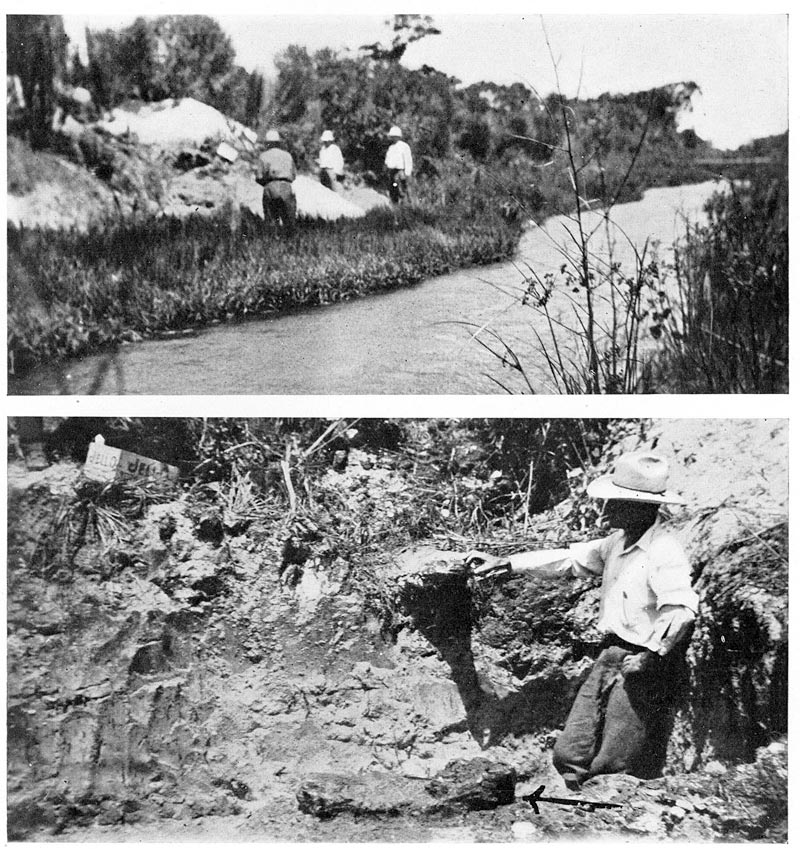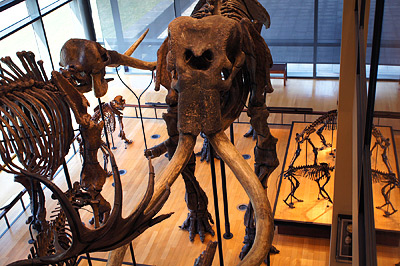Melbourne
University of Florida Vertebrate Fossil Locality BR002
Location
Western part of the city of Melbourne, Brevard County, Florida, at about 28.1° N, 80.6° W. Three separate localities were reported by Gidley and Loomis (1926), of which two produced almost all of the fossils in museum collections. The Golf Course locality was located on the east bank of Crane Creek where it crossed the Melbourne Golf and Country Club (south of West New Haven Avenue), and extended for a distance of at least 100 feet (30 meters) with an average width of 30 feet (10 m) (Gidley and Loomis, 1926; Gidley, 1929). The Singleton Estate locality was about 1 mile south-southwest of the Golf Course locality in what was at the time an orange grove owned by C. P. Singleton (Loomis, 1924; Gidley and Loomis, 1926). The least productive of the sites was on the south bank of the channelized Crane Creek about one mile west of the golf course.
Age
- Late Pleistocene Epoch; Rancholabrean land mammal age
- About 11,000 to 25,000 years old (estimated)
Basis of Age
Biochronology (presence of Sigmodon hispidus, Oryzomys palustris, Canis dirus, Tremarctos floridanus, Puma concolor, and Glyptotherium floridanum indicates a late Rancholabrean age (Webb, 1974; Morgan and Seymour, 1997). The fossils also come from a geologic unit lying in superposition above the Anastasia Formation (or its equivalent), which is generally regarded in this region as having been deposited during the last major interglacial (marine isotope stage 5), or about 125,000 years ago. Thus the vertebrate fossils must be younger than that date.
Geology
Fossils derive from a 4- to 5-foot-thick (120-150 cm) bed of fine brown sand (Gidley, 1929). This horizon is called Bed 2 in the scientific literature of the 1920s and 1930s. It rests unconformably on a shelly sand (Bed 1), often referred to the Anastasia Formation. The top of Bed 2 is an irregular erosional unconformity. The uppermost unit, Bed 3, is comprised of alternating layers of sand and decomposed plant matter, which Gidley (1929) regarded as a swamp deposit.
Depositional Environment
Bed 2 is usually regarded as stream channel and flood deposits, although Gidley (1929) proposed that it was of eolian origin (wind-blown).
Fossils

Excavation History and Methods
Fossils in the Melbourne area were discovered by local resident C. P. Singleton and reported to the Smithsonian Institution in 1922 (Gidley and Loomis, 1926). In the course of excavating two mammoth skeletons in December, 1923, Frederick Loomis (1873-1937) of Amherst College recovered stone artifacts and human-modified bones in apparent association with extinct Pleistocene mammoths (Loomis, 1924). One of the mammoth skeletons collected by Loomis was restored, mounted, and displayed at the science museum on the campus of Amherst College. It is very likely the first mounted skeleton of a fossil from Florida placed on public display in a museum, and it can still be seen today (Figure 2). In 1925, joint excavations by Loomis and James Gidley (1866-1931) of the Smithsonian commenced, with the primary goal to determine if the human artifacts and remains were Pleistocene in age. Gidley’s collecting efforts continued until at least 1929. Also in 1925, C P. Singleton donated may of the fossils he and his employees had collected up to that point, dividing them between the Smithsonian and Amherst College. Singleton also continued his own excavations from 1925 to at least 1928 at the Golf Course locality when Loomis and Gidley were not present, apparently with funding from Harvard University and permission of the Smithsonian (Ray, 1958). These specimens are housed in the Museum of Comparative Zoology at Harvard University.
Gidley and Loomis were well aware of the controversy surrounding the discovery a decade earlier of human bones found with those of extinct Pleistocene mammals in Vero Beach, Florida (Gidley and Loomis, 1926). Thus, for the time, their excavations were very careful, especially with regards to the stratigraphic positions of the bones (e.g., Gidley, 1927, 1929). There is no record of screenwashing of sediment (this was before the method was commonplace), but the recovery of large numbers of fossils of small rodents indicates that the sediments were dug carefully.
Discussion

Melbourne was one of the “Big Three” late Pleistocene sites discovered in Florida during the first half of the 20th Century. The other two were the Vero Canal Site in Indian River County and the Seminole Field Site in Pinellas County. In combination or separately they have been responsible for many dozens of scientific publications. Many of them were related to the human bones and/or artifacts possibly found in the same deposits as those of Pleistocene vertebrates, at the time a very controversial idea and one not endorsed by the mainstream archaeological community. Prior to 1950, there was also controversy between paleontologists about whether the age of these sites was early or late Pleistocene. All three of these sites were found along Florida’s densely populated and highly developed coastline. Relatively few large sites such as these have been found since the 1930s. It is likely that many more lie undiscovered hidden below shopping malls, parking lots, condos, and suburban homes and yards.
With few exceptions, there have not been many detailed studies of the non-human fossils found at Melbourne, especially given the large size and well-preserved nature of the available samples. Some of this is due to the death of Gidley in 1931, preventing him from completing his planned study of the mammals. Also the fact that the collection is divided between three institutions makes its study more difficult. Overall, the make-up of the large mammal fauna at Melbourne is very similar to Seminole Field, with browsers (deer, tapir, mastodon, Mylohyus) and grazers (Equus, Bison, mammoth) about equally abundant. The species numbers of carnivores and small mammals are greater at Melbourne and the sloth Megalonyx is more common.
Gidley (in Hay, 1927) listed 36 species of mammals (excluding human), 7 species of reptiles, one fish, and 4 birds from the Melbourne sites up through the 1926 field season. Many of the species names listed by Gidley were provisional, and their identifications changed based on further study (Gazin, 1950; Ray, 1958). Gilmore (1927) described a new species of large box turtle from the site and figured a number of specimens. Wetmore (1931) included Melbourne specimens in his review of Pleistocene birds from Florida. Simpson (1929) briefly described but did not figure a partial mandible of Dasypus bellus from Melbourne, at the time the only known cranial material of the species. Later, Simpson (1941) described in detail and figured a mandible of the jaguar, Panthera onca, from Melbourne. Osborn (1942) described and figured the Amherst mammoth skeleton from Melbourne (Figure 2), including measurements of its teeth and limbs. Gazin (1950) very briefly described from Melbourne as new a small species of rabbit, Sylvilagus palustrellus. The status and legitimacy of this species is debatable. Ray (1958) presented detailed descriptions or illustrations of only a few species, most notably a mandible of a wolf (either Canis lupus or Canis rufus; identified as Canis rufus by Nowak, 2002); a toe bone of the monk seal Monachus tropicalis, and two small rodents, Peromyscus gossypinus and Oryzomys palustris.
Oddly enough, one of the most studied of the Melbourne fossils is a single mandible of a large, insectivorous bat. In 1932, Glover Allen described this specimen as a new genus and species in the family Molossidae, which he called Molossides floridanus. Ray et al. (1963) reexamined the specimen and concluded that it should be referred to the living genus Eumops, the bonnet-head bats. Koopman (1971) and Morgan (1991, 2002) regarded it an extinct subspecies of the living species Eumops glaucinus. But more recently, Timm and Genoways (2004) have raised it back to full species rank, as Eumops floridanus, and include in the species a rare, living population in southernmost Florida. This makes it one of the few instances since 1900 when a species is named based on fossil material and thought to be extinct, but is then later determined to still be extant.
Sources
- Original Author(s): Richard C. Hulbert Jr.
- Original Completion Date: September 15, 2013
- Editor(s) Name(s): Richard C. Hulbert Jr., Natali Valdes
- Last Updated On: March 4, 2015
This material is based upon work supported by the National Science Foundation under Grant Number CSBR 1203222, Jonathan Bloch, Principal Investigator. Any opinions, findings, and conclusions or recommendations expressed in this material are those of the author(s) and do not necessarily reflect the views of the National Science Foundation.
Copyright © Florida Museum of Natural History, University of Florida